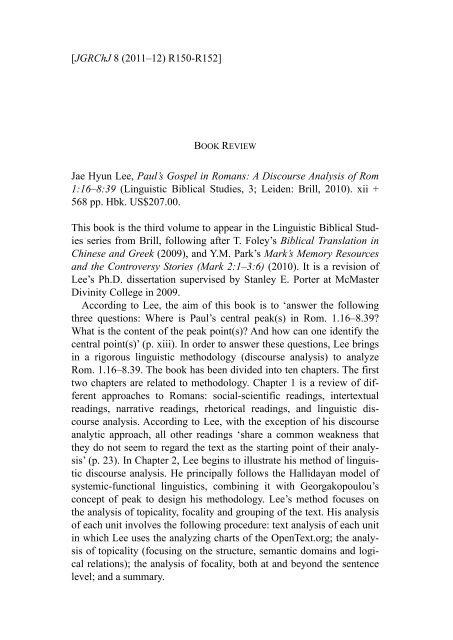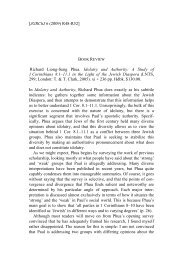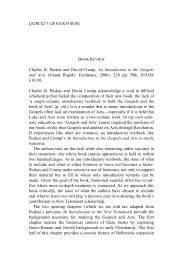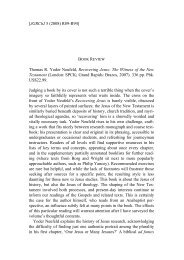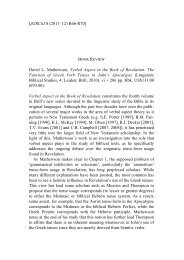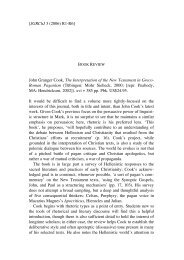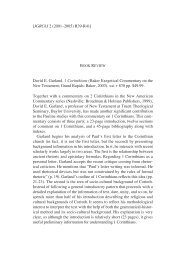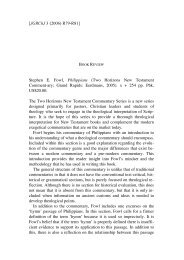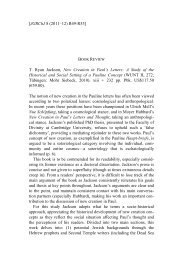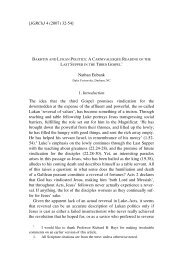Jae Hyun Lee, Paul's Gospel in Romans - Journal of Greco-Roman ...
Jae Hyun Lee, Paul's Gospel in Romans - Journal of Greco-Roman ...
Jae Hyun Lee, Paul's Gospel in Romans - Journal of Greco-Roman ...
Create successful ePaper yourself
Turn your PDF publications into a flip-book with our unique Google optimized e-Paper software.
[JGRChJ 8 (2011–12) R150-R152]<br />
BOOK REVIEW<br />
<strong>Jae</strong> <strong>Hyun</strong> <strong>Lee</strong>, Paul’s <strong>Gospel</strong> <strong>in</strong> <strong><strong>Roman</strong>s</strong>: A Discourse Analysis <strong>of</strong> Rom<br />
1:16–8:39 (L<strong>in</strong>guistic Biblical Studies, 3; Leiden: Brill, 2010). xii +<br />
568 pp. Hbk. US$207.00.<br />
This book is the third volume to appear <strong>in</strong> the L<strong>in</strong>guistic Biblical Studies<br />
series from Brill, follow<strong>in</strong>g after T. Foley’s Biblical Translation <strong>in</strong><br />
Ch<strong>in</strong>ese and Greek (2009), and Y.M. Park’s Mark’s Memory Resources<br />
and the Controversy Stories (Mark 2:1–3:6) (2010). It is a revision <strong>of</strong><br />
<strong>Lee</strong>’s Ph.D. dissertation supervised by Stanley E. Porter at McMaster<br />
Div<strong>in</strong>ity College <strong>in</strong> 2009.<br />
Accord<strong>in</strong>g to <strong>Lee</strong>, the aim <strong>of</strong> this book is to ‘answer the follow<strong>in</strong>g<br />
three questions: Where is Paul’s central peak(s) <strong>in</strong> Rom. 1.16–8.39?<br />
What is the content <strong>of</strong> the peak po<strong>in</strong>t(s)? And how can one identify the<br />
central po<strong>in</strong>t(s)’ (p. xiii). In order to answer these questions, <strong>Lee</strong> br<strong>in</strong>gs<br />
<strong>in</strong> a rigorous l<strong>in</strong>guistic methodology (discourse analysis) to analyze<br />
Rom. 1.16–8.39. The book has been divided <strong>in</strong>to ten chapters. The first<br />
two chapters are related to methodology. Chapter 1 is a review <strong>of</strong> different<br />
approaches to <strong><strong>Roman</strong>s</strong>: social-scientific read<strong>in</strong>gs, <strong>in</strong>tertextual<br />
read<strong>in</strong>gs, narrative read<strong>in</strong>gs, rhetorical read<strong>in</strong>gs, and l<strong>in</strong>guistic discourse<br />
analysis. Accord<strong>in</strong>g to <strong>Lee</strong>, with the exception <strong>of</strong> his discourse<br />
analytic approach, all other read<strong>in</strong>gs ‘share a common weakness that<br />
they do not seem to regard the text as the start<strong>in</strong>g po<strong>in</strong>t <strong>of</strong> their analysis’<br />
(p. 23). In Chapter 2, <strong>Lee</strong> beg<strong>in</strong>s to illustrate his method <strong>of</strong> l<strong>in</strong>guistic<br />
discourse analysis. He pr<strong>in</strong>cipally follows the Hallidayan model <strong>of</strong><br />
systemic-functional l<strong>in</strong>guistics, comb<strong>in</strong><strong>in</strong>g it with Georgakopoulou’s<br />
concept <strong>of</strong> peak to design his methodology. <strong>Lee</strong>’s method focuses on<br />
the analysis <strong>of</strong> topicality, focality and group<strong>in</strong>g <strong>of</strong> the text. His analysis<br />
<strong>of</strong> each unit <strong>in</strong>volves the follow<strong>in</strong>g procedure: text analysis <strong>of</strong> each unit<br />
<strong>in</strong> which <strong>Lee</strong> uses the analyz<strong>in</strong>g charts <strong>of</strong> the OpenText.org; the analysis<br />
<strong>of</strong> topicality (focus<strong>in</strong>g on the structure, semantic doma<strong>in</strong>s and logical<br />
relations); the analysis <strong>of</strong> focality, both at and beyond the sentence<br />
level; and a summary.
R151 <strong>Journal</strong> <strong>of</strong> <strong>Greco</strong>-<strong>Roman</strong> Christianity and Judaism 8<br />
In the subsequent chapters, <strong>Lee</strong> demonstrates that Paul uses two descriptive<br />
frameworks to express the gospel <strong>of</strong> salvation: ‘(1) an <strong>in</strong>teractive<br />
framework between God and humans; and (2) a contrast between<br />
the old realm and the new’ (p. 431). Here is the content <strong>of</strong> Paul’s gospel:<br />
salvation <strong>in</strong> the <strong>in</strong>teractive framework is expressed as God’s<br />
reward-gift to people who have faith; and <strong>in</strong> the two-realm framework<br />
it relates to the transition <strong>of</strong> believers from the old realm (under the<br />
power <strong>of</strong> s<strong>in</strong>, death, etc.) to the alternative new one (union with God’s<br />
grace and eternal life). Chapter 3 deals with Rom. 1.16-17, which<br />
serves as an <strong>in</strong>troduction to Paul’s gospel as salvation to all believers.<br />
The next two chapters are about the <strong>in</strong>teractive paradigm between human<br />
s<strong>in</strong>fulness and God’s wrathful judgment throughout Rom. 1.18–<br />
3.20. Chapter 6 shows a new salvific <strong>in</strong>teractive paradigm <strong>in</strong> Rom.<br />
3.21–4.25, which focuses on ‘the <strong>in</strong>teraction between human faith and<br />
God’s gracious salvation’ (p. 213) <strong>in</strong> the forensic dimension.<br />
Chapter 7 discusses the fact that Jesus holds the central role <strong>in</strong> <strong><strong>Roman</strong>s</strong><br />
5, which not only <strong>in</strong>cludes the previous topical issues, but also<br />
provides a more complete picture <strong>of</strong> salvation than before. It adds a relational<br />
dimension, an aspect <strong>of</strong> the future state, and <strong>in</strong>troduces a tworealm<br />
framework <strong>in</strong> describ<strong>in</strong>g salvation <strong>in</strong> which believers are transferred<br />
from the dom<strong>in</strong>ion <strong>of</strong> s<strong>in</strong> and death to the new realm <strong>of</strong> God’s<br />
grace.<br />
In Chapter 8, <strong>Lee</strong> argues that <strong>in</strong> Rom. 6.1–7.25 Paul describes the<br />
two contrast<strong>in</strong>g realms <strong>of</strong> a believer’s life. The first unit, Rom. 6.1–7.6,<br />
focuses on the believer’s new life <strong>in</strong> the realm <strong>of</strong> eternal life. In the<br />
second unit, Rom. 7.7-25, Paul shows ‘the seriousness <strong>of</strong> s<strong>in</strong> <strong>in</strong> human<br />
life…through the depiction <strong>of</strong> a tragic situation <strong>of</strong> the unregenerate person<br />
<strong>in</strong> Rom. 7.7-25’ (p. 378). In Chapter 9, <strong>Lee</strong> <strong>in</strong>dicates that Rom.<br />
8.1-39 gives a supplementary view on God’s salvific works <strong>in</strong> which<br />
Paul provides a detailed explanation about the role <strong>of</strong> the Spirit <strong>in</strong> respect<br />
to the life <strong>of</strong> believers.<br />
In the last chapter, <strong>Lee</strong> concludes that Paul’s gospel about God’s salvation<br />
has one peak po<strong>in</strong>t <strong>in</strong> <strong><strong>Roman</strong>s</strong> 5 and two sub-peaks <strong>in</strong> Rom.<br />
3.21-26 and <strong><strong>Roman</strong>s</strong> 8, respectively. Appendices 1 and 2 are related to<br />
the analysis <strong>of</strong> Rom. 1.16–8.39 accord<strong>in</strong>g to the frame <strong>of</strong> topicality and<br />
semantic doma<strong>in</strong>s, respectively.<br />
This book makes a great contribution to biblical studies <strong>in</strong> terms <strong>of</strong> a<br />
l<strong>in</strong>guistic discourse approach. S<strong>in</strong>ce not many New Testament texts<br />
have been considered from this perspective, such a methodology will
Review: LEE Paul’s <strong>Gospel</strong> <strong>in</strong> <strong><strong>Roman</strong>s</strong><br />
R152<br />
become more and more important as a text-orientated approach. It is a<br />
great achievement <strong>in</strong> model<strong>in</strong>g a new discourse analysis based on the<br />
analysis <strong>of</strong> semantic doma<strong>in</strong>s. Moreover, <strong>Lee</strong>’s discourse analysis is a<br />
well-designed l<strong>in</strong>guistic method. The analysis is logical and smooth.<br />
This method can help to determ<strong>in</strong>e the flow <strong>of</strong> thought <strong>of</strong> Paul’s argument,<br />
which saves some seem<strong>in</strong>gly controversial texts <strong>in</strong> <strong><strong>Roman</strong>s</strong> (e.g.<br />
7.7-25) from unceas<strong>in</strong>g debates.<br />
However, there are a few th<strong>in</strong>gs worth notic<strong>in</strong>g. First, <strong>Lee</strong> determ<strong>in</strong>es<br />
<strong><strong>Roman</strong>s</strong> 5 as the central po<strong>in</strong>t <strong>of</strong> God’s salvific gospel through his<br />
analysis <strong>of</strong> Rom. 1.16–8.39 without <strong>in</strong>clud<strong>in</strong>g the analysis <strong>of</strong> other<br />
chapters. Contrary to <strong>Lee</strong>’s assumption that Rom. 1.16–8.39 is a central<br />
part <strong>of</strong> the Epistle, it is <strong><strong>Roman</strong>s</strong> 9–11 that recent scholarship has considered<br />
as the climax <strong>of</strong> the book. Secondly, <strong>Lee</strong>’s analysis, though<br />
clear, seems overly simple. He does not explore some controversial but<br />
significant issues <strong>in</strong> depth. For example, <strong>Lee</strong> has not expla<strong>in</strong>ed what he<br />
means by ‘the Gentiles can be regarded as law-possessors by do<strong>in</strong>g the<br />
law’, when the Gentiles refer to non-Christians (p. 164).What does he<br />
mean by ‘do<strong>in</strong>g the law’ here? Does he mean do<strong>in</strong>g the whole law? Or<br />
do<strong>in</strong>g part <strong>of</strong> the law? In addition, <strong>Lee</strong> has not expla<strong>in</strong>ed the mean<strong>in</strong>g<br />
<strong>of</strong> ‘the doers <strong>of</strong> the law will be justified’, except for po<strong>in</strong>t<strong>in</strong>g out that<br />
‘the statement <strong>in</strong> v. 13 functions to show how far God’s justification is<br />
from the Jews who lack the obedience to the law despite their possession<br />
<strong>of</strong> it’ (pp. 160, 166). <strong><strong>Roman</strong>s</strong> 2.13 is an important but controversial<br />
verse, which has been the subject <strong>of</strong> heated debates, but <strong>Lee</strong> does not<br />
refer to them. Furthermore, there appears to be some small errors <strong>in</strong> his<br />
book. For <strong>in</strong>stance, accord<strong>in</strong>g to <strong>Lee</strong>’s text analysis, this reviewer<br />
counts that there are seven primary clauses <strong>in</strong> Rom. 4.9-12, not eight as<br />
<strong>Lee</strong> suggests (p. 250). Also, one edit<strong>in</strong>g error: p. 362 is blank, where<br />
there should appear the text analysis <strong>of</strong> Rom. 7.15-18. Overall, it is a<br />
good book worth read<strong>in</strong>g. It will be helpful particularly <strong>in</strong> l<strong>in</strong>guistically<br />
oriented approaches to biblical studies.<br />
Xiaxia Xue<br />
McMaster Div<strong>in</strong>ity College


